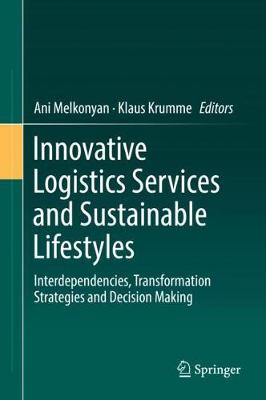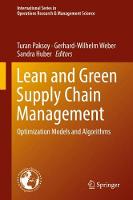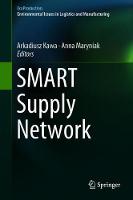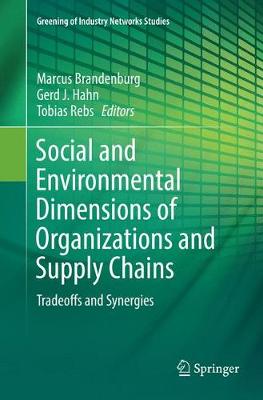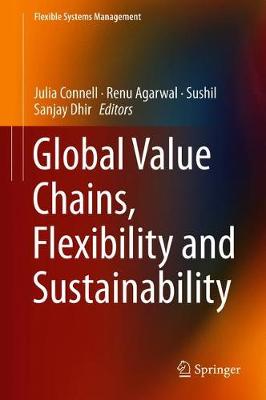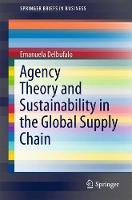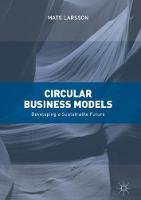Circular Business Models
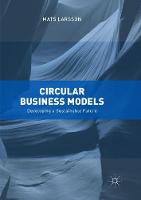 -15%
portes grátis
-15%
portes grátis
Circular Business Models
Developing a Sustainable Future
Larsson, Mats
Springer International Publishing AG
06/2019
303
Mole
Inglês
9783319891064
15 a 20 dias
454
The Science of Problem Solving. 11
References. 12
Part One - Business and Organizational Aspects of Circular Economies. 13
2. Development as a Process of Organization.. 13
The Organization of a Circular Economy. 15
A Development Over a Century. 17
References. 19
3. The Author's Journey. 20
Earlier Thoughts on Sustainability, Circular Economy, and Transformation.. 21
Sustainability. 21
Circular Economy. 22
Technology Development, Business Transformation, and Peak Oil 23
References. 23
4. The Circular Economy and Business Challenges. 25
Understanding Innovation and Business Development 26
Imminent Threats. 28
Crossing the Chasm - from Idealistic to Demanding Customers. 30
Carbon Dioxide and Global Warming vs. Resource Depletion.. 31
The Experience Curve. 32
References. 33
5. Complexity - The Tightly Woven Fabric of Society. 34
Complexity in Modern Society. 34
The Increasing Specialization in the Linear Economy. 36
Increasing Specialization of the Circular Economy. 37
References. 38
6. Could Resource Shortages Cause Problems?. 39
Complex Development 41
A Development in Steps. 42
Driving Change. 46
A Collaborative Effort 46
A Systems Perspective. 47
References. 47
7. Multiple Helix Collaboration for the Development of a Circular Economy. 48
A Multipe-Helix Innovation System.. 48
The Role of Governments. 49
Research and Training. 51
Non-Government Organizations. 52
Civic Society and the General Public. 53
Company and Public Sector Procurement 54
References. 55
8. Managing Change. 56
Change Management 58
Examples of Roles. 60
Early Phases of Transformation.. 60
The Savings Paradox. 61
Dismantling Obsolete Systems. 63
Mind-Set and Behaviour Change. 64
Leading Through Change. 64
The Resource Based View of Business Strategy. 66
References. 68
Part Two - Challenges by industry and business sector 69
9. Local Production and Distribution Systems. 69
The Current Situation.. 70
Transformation to Local Production and Distribution Systems. 70
The Development of Local Markets. 71
Efficient Systems for Local Production.. 72
Local Value Chains. 73
Local Food Production.. 73
Volume Growth.. 74
Secondary Qualities. 76
The Role of Large Firms. 77
Customers Form Industries. 78
Steps to Change. 78
Step 1: Local Stand-Alone Concepts. 79
Step 2: Local Production and Distribution Concepts. 79
Step 3: Integrated Local Value Chains. 80
Step 4: Volume Competition.. 81
Step 5: Local and Circular Concepts Dominate. 81
Disruptive Aspects of Change. 81
From Global to Local Production and Distribution.. 82
Procurement Strategies. 82
A New Focus. 83
Opportunities for Local Production Offered by Digitalization.. 84
Changing Customer Preferences. 85
Step 1: Indifferent Majority. 86
Step 2: Emerging Preferences. 86
Step 3: Widespread Adoption and Volume Growth.. 86
Step 4: Circular Majority. 87
Step 5: Preferences for Local and Circular Concepts Dominate. 87
References. 87
10. Sharing and Extended Use. 88
The Present Situation.. 88
Sharing Models. 88
Growth Opportunities and Patterns of Use. 90
The Product as a Service. 92
Inexpensive Alternatives. 92
Potential Growth Areas. 92
Integration.. 92
Flow.. 92
High Value. 93
Genuinely Circular?. 93
Steps to Change. 94
Step 1: Pilot Sharing Models. 95
Step 2: More Customers Prioritize Sharing. 95
Step 3: Sharing becomes the new normal 96
Aspects of Disruptive Change. 96
Extended Use. 97
Services Targeted at Consumers. 97
Business-to-Business. 99
Steps to Product Life Extension.. 100
Step 1 - Occasional Extended Use. 101
Step 2: Behaviour Change and Systems in Place. 101
Step 3: Extended Use Becomes a Priority. 102
Step 4: Extended Use Becomes the Norm.. 103
Aspects of Disruptive Change. 103
References. 103
11. Standardization and modularization.. 104
The Development and Growth of Lean Production.. 105
Design and Re-design.. 108
Step 1: Pilot Modularization.. 109
Step 2: Training and research.. 109
Step 3: Widespread adoption.. 109
Step 4: Legislation and procurement requirements. 110
Step 5: Modularization Becomes the Norm.. 111
Aspects of Disruptive Change. 111
References. 111
12. Recycling and Upcycling. 112
Corporate Re-manufacturing. 113
Materials Recycling. 114
Materials Difficult to Recycle. 114
Steps to Recycling and Upcycling. 115
Step 1: Recycling and Incineration.. 115
Step 2: Increased Materials Recycling. 116
Step 3: Increased Upcycling. 116
Step 4: Increased Use of Biologically Based Materials. 116
Aspects of Disruptive Change. 116
References. 116
13. Biologically based materials. 117
Existing value chains. 118
Transforming Plastics. 118
Plastics from Wood. 121
Competition with Food Production.. 121
The Volume Issue. 121
Steps to New Materials. 123
Step 1: Pilot Introduction.. 123
Step 2: Volume Growth.. 124
Step 3: Resource Constraints. 124
Step 4: Reduction and Restructuring of Use of Materials. 124
Aspects of Disruptive Change. 124
References. 125
14. Transportation systems, renewable fuels and energy efficiency. 126
Scarcity and Climate Change. 126
Reduced Dependence on Oil?. 128
The British Fuel Crisis. 129
The Challenge of Transportation.. 129
A Web of Interrelationships. 135
Saving Power in Existing Applications. 136
Steps to the Transformation of Transport Systems. 138
Step 1: Early Adopters and Innovators Buy. 138
Step 2: Volume Growth.. 138
Step 3: Electric Car Dominance. 139
Step 4: The Last of Petroleum Cars. 140
Steps for Heavy Vehicles. 140
Market Analysis and Programme Planning. 142
References. 146
15. Construction, Infrastructure, and Digital Technologies. 147
Examples of Circular Models in Construction Related Areas. 148
Healthy and Sustainable Buildings. 148
Flooring. 148
Digitalization.. 149
Examples of Circular Business Models Based on Digital Technologies. 149
The Main Direction of Digital Development 149
Brief, But Important 150
References. 150
16. Life Sustaining Resources and Technologies. 151
Health Care. 151
Utilities. 152
Work. 153
Risk Management 153
References. 154
17. Financial Innovations. 155
Financial Risk Taking. 156
Financial Innovations Support Circular Development 157
Crowd Funding. 157
Complementary Monetary Systems. 158
Cryptocurrencies. 159
Reforming the Global Economy?. 160
Aspects of Disruptive Change. 161
References. 162
18. General Purpose Technologies as the Basis for Transformation.. 163
The Organization of Hypocrisy and Organization Man.. 165
Is Rapid Transformation Possible?. 167
The Transformation of US Industry to War Production.. 168
The Marshall Plan.. 169
The Apollo Program.. 170
Venice and the Preparations for the Fourth Crusade. 170
The Volume Issue Revisited. 171
References. 172
Part Three - A Way Forward. 173
19. Risks and Logical Fallacies. 173
Great Expectations. 174
Some Numbers. 176
Peak Oil 176
Peak Gas. 177
Phosphorous. 177
Rare Earth Elements. 178
The Paths of Peak Resources. 178
Understanding and prioritizing. 180
Decision Theory. 182
Fallacies of Experts and Decision Makers. 183
Failure to Realise That Society is Vulnerable. 183
Failure to Recognize the Scale and the Systemic Aspects. 184
Failure to Understand Markets. 184
Mistaking the Problem for the Solution.. 184
Mistaking a High-Level Description of the Solution for the Transformation Strategy and Plan 185
References. 185
20. Planning The Way Forward and Reality Check. 186
Steps to Circular Economic Flows. 186
Step 1: Trying Out Circular Models on a Small Scale. 186
Step 2: Evaluation of Progress and Simulation of Scale-Up. 186
Step 3: Avoidance of Conclusions. 186
Step 4: Prioritization.. 187
Step 5: Development of Strategies. 187
Reality Check. 187
Increasing Complexity Complicates Change. 187
Few Short Term Incentives to Change. 188
Little Experience of Resource Shortages. 188
Focus on a Description of Energy and Fuel Resources as a Sources of Pollution.. 188
It Takes Time to Calibrate World-Views and Resource Needs. 188
Will Decisions Be Made in Time?. 189
21. Paradigms, at Last 190
Scientific Revolutions. 190
The Circular Economy as a Paradigm Shift 191
Merging Paradigms. 192
References. 193
Epilogue 194
The Science of Problem Solving. 11
References. 12
Part One - Business and Organizational Aspects of Circular Economies. 13
2. Development as a Process of Organization.. 13
The Organization of a Circular Economy. 15
A Development Over a Century. 17
References. 19
3. The Author's Journey. 20
Earlier Thoughts on Sustainability, Circular Economy, and Transformation.. 21
Sustainability. 21
Circular Economy. 22
Technology Development, Business Transformation, and Peak Oil 23
References. 23
4. The Circular Economy and Business Challenges. 25
Understanding Innovation and Business Development 26
Imminent Threats. 28
Crossing the Chasm - from Idealistic to Demanding Customers. 30
Carbon Dioxide and Global Warming vs. Resource Depletion.. 31
The Experience Curve. 32
References. 33
5. Complexity - The Tightly Woven Fabric of Society. 34
Complexity in Modern Society. 34
The Increasing Specialization in the Linear Economy. 36
Increasing Specialization of the Circular Economy. 37
References. 38
6. Could Resource Shortages Cause Problems?. 39
Complex Development 41
A Development in Steps. 42
Driving Change. 46
A Collaborative Effort 46
A Systems Perspective. 47
References. 47
7. Multiple Helix Collaboration for the Development of a Circular Economy. 48
A Multipe-Helix Innovation System.. 48
The Role of Governments. 49
Research and Training. 51
Non-Government Organizations. 52
Civic Society and the General Public. 53
Company and Public Sector Procurement 54
References. 55
8. Managing Change. 56
Change Management 58
Examples of Roles. 60
Early Phases of Transformation.. 60
The Savings Paradox. 61
Dismantling Obsolete Systems. 63
Mind-Set and Behaviour Change. 64
Leading Through Change. 64
The Resource Based View of Business Strategy. 66
References. 68
Part Two - Challenges by industry and business sector 69
9. Local Production and Distribution Systems. 69
The Current Situation.. 70
Transformation to Local Production and Distribution Systems. 70
The Development of Local Markets. 71
Efficient Systems for Local Production.. 72
Local Value Chains. 73
Local Food Production.. 73
Volume Growth.. 74
Secondary Qualities. 76
The Role of Large Firms. 77
Customers Form Industries. 78
Steps to Change. 78
Step 1: Local Stand-Alone Concepts. 79
Step 2: Local Production and Distribution Concepts. 79
Step 3: Integrated Local Value Chains. 80
Step 4: Volume Competition.. 81
Step 5: Local and Circular Concepts Dominate. 81
Disruptive Aspects of Change. 81
From Global to Local Production and Distribution.. 82
Procurement Strategies. 82
A New Focus. 83
Opportunities for Local Production Offered by Digitalization.. 84
Changing Customer Preferences. 85
Step 1: Indifferent Majority. 86
Step 2: Emerging Preferences. 86
Step 3: Widespread Adoption and Volume Growth.. 86
Step 4: Circular Majority. 87
Step 5: Preferences for Local and Circular Concepts Dominate. 87
References. 87
10. Sharing and Extended Use. 88
The Present Situation.. 88
Sharing Models. 88
Growth Opportunities and Patterns of Use. 90
The Product as a Service. 92
Inexpensive Alternatives. 92
Potential Growth Areas. 92
Integration.. 92
Flow.. 92
High Value. 93
Genuinely Circular?. 93
Steps to Change. 94
Step 1: Pilot Sharing Models. 95
Step 2: More Customers Prioritize Sharing. 95
Step 3: Sharing becomes the new normal 96
Aspects of Disruptive Change. 96
Extended Use. 97
Services Targeted at Consumers. 97
Business-to-Business. 99
Steps to Product Life Extension.. 100
Step 1 - Occasional Extended Use. 101
Step 2: Behaviour Change and Systems in Place. 101
Step 3: Extended Use Becomes a Priority. 102
Step 4: Extended Use Becomes the Norm.. 103
Aspects of Disruptive Change. 103
References. 103
11. Standardization and modularization.. 104
The Development and Growth of Lean Production.. 105
Design and Re-design.. 108
Step 1: Pilot Modularization.. 109
Step 2: Training and research.. 109
Step 3: Widespread adoption.. 109
Step 4: Legislation and procurement requirements. 110
Step 5: Modularization Becomes the Norm.. 111
Aspects of Disruptive Change. 111
References. 111
12. Recycling and Upcycling. 112
Corporate Re-manufacturing. 113
Materials Recycling. 114
Materials Difficult to Recycle. 114
Steps to Recycling and Upcycling. 115
Step 1: Recycling and Incineration.. 115
Step 2: Increased Materials Recycling. 116
Step 3: Increased Upcycling. 116
Step 4: Increased Use of Biologically Based Materials. 116
Aspects of Disruptive Change. 116
References. 116
13. Biologically based materials. 117
Existing value chains. 118
Transforming Plastics. 118
Plastics from Wood. 121
Competition with Food Production.. 121
The Volume Issue. 121
Steps to New Materials. 123
Step 1: Pilot Introduction.. 123
Step 2: Volume Growth.. 124
Step 3: Resource Constraints. 124
Step 4: Reduction and Restructuring of Use of Materials. 124
Aspects of Disruptive Change. 124
References. 125
14. Transportation systems, renewable fuels and energy efficiency. 126
Scarcity and Climate Change. 126
Reduced Dependence on Oil?. 128
The British Fuel Crisis. 129
The Challenge of Transportation.. 129
A Web of Interrelationships. 135
Saving Power in Existing Applications. 136
Steps to the Transformation of Transport Systems. 138
Step 1: Early Adopters and Innovators Buy. 138
Step 2: Volume Growth.. 138
Step 3: Electric Car Dominance. 139
Step 4: The Last of Petroleum Cars. 140
Steps for Heavy Vehicles. 140
Market Analysis and Programme Planning. 142
References. 146
15. Construction, Infrastructure, and Digital Technologies. 147
Examples of Circular Models in Construction Related Areas. 148
Healthy and Sustainable Buildings. 148
Flooring. 148
Digitalization.. 149
Examples of Circular Business Models Based on Digital Technologies. 149
The Main Direction of Digital Development 149
Brief, But Important 150
References. 150
16. Life Sustaining Resources and Technologies. 151
Health Care. 151
Utilities. 152
Work. 153
Risk Management 153
References. 154
17. Financial Innovations. 155
Financial Risk Taking. 156
Financial Innovations Support Circular Development 157
Crowd Funding. 157
Complementary Monetary Systems. 158
Cryptocurrencies. 159
Reforming the Global Economy?. 160
Aspects of Disruptive Change. 161
References. 162
18. General Purpose Technologies as the Basis for Transformation.. 163
The Organization of Hypocrisy and Organization Man.. 165
Is Rapid Transformation Possible?. 167
The Transformation of US Industry to War Production.. 168
The Marshall Plan.. 169
The Apollo Program.. 170
Venice and the Preparations for the Fourth Crusade. 170
The Volume Issue Revisited. 171
References. 172
Part Three - A Way Forward. 173
19. Risks and Logical Fallacies. 173
Great Expectations. 174
Some Numbers. 176
Peak Oil 176
Peak Gas. 177
Phosphorous. 177
Rare Earth Elements. 178
The Paths of Peak Resources. 178
Understanding and prioritizing. 180
Decision Theory. 182
Fallacies of Experts and Decision Makers. 183
Failure to Realise That Society is Vulnerable. 183
Failure to Recognize the Scale and the Systemic Aspects. 184
Failure to Understand Markets. 184
Mistaking the Problem for the Solution.. 184
Mistaking a High-Level Description of the Solution for the Transformation Strategy and Plan 185
References. 185
20. Planning The Way Forward and Reality Check. 186
Steps to Circular Economic Flows. 186
Step 1: Trying Out Circular Models on a Small Scale. 186
Step 2: Evaluation of Progress and Simulation of Scale-Up. 186
Step 3: Avoidance of Conclusions. 186
Step 4: Prioritization.. 187
Step 5: Development of Strategies. 187
Reality Check. 187
Increasing Complexity Complicates Change. 187
Few Short Term Incentives to Change. 188
Little Experience of Resource Shortages. 188
Focus on a Description of Energy and Fuel Resources as a Sources of Pollution.. 188
It Takes Time to Calibrate World-Views and Resource Needs. 188
Will Decisions Be Made in Time?. 189
21. Paradigms, at Last 190
Scientific Revolutions. 190
The Circular Economy as a Paradigm Shift 191
Merging Paradigms. 192
References. 193
Epilogue 194

